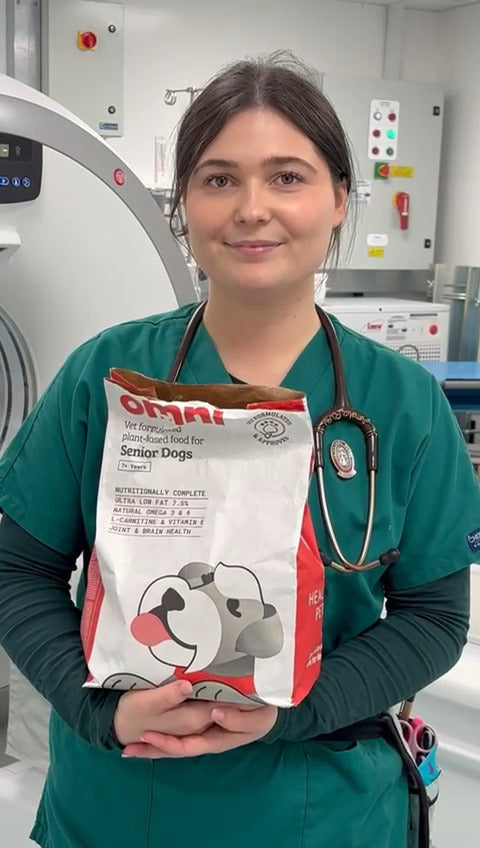Bladder Care Supplement for Dogs – Soothe & Support Urinary Health

Bladder Care Supplement: Keep Your Dog’s Bladder and Urinary Tract Healthy
27% of our doggy companions will get a urinary tract infection at some stage in their lives, mostly from pathogenic bacteria. It can be very uncomfortable and quite painful for your dog, so it’s important to know how to best take care of them.
Omni’s brand-new Bladder Care Supplement is specifically formulated to support healthy bladder function and soothe the urinary tract. With ingredients like Marshmallow Root, Cranberry Juice, and D-Mannose, this natural, vet-grade 1-a-day soft chew is an ideal solution for dogs prone to urinary issues.
Perfect for dogs who:
Introduction
Bladder health is critical for your dog's overall wellbeing, and urinary tract issues can be uncomfortable and distressing for them. Our Bladder Care Supplement is formulated by our expert veterinarians to soothe the urinary tract and support healthy bladder function. Free from animal-origin ingredients, it’s proven safe, effective, natural, and environmentally sustainable. What’s not to love?
What is the Bladder Care Supplement?
The Bladder Care Supplement is a 1-a-day soft chew designed to promote urinary tract health and improve bladder function. Crafted with powerful ingredients like Marshmallow Root, Cranberry Juice, and D-Mannose, our new Bladder Care Supplement helps reduce inflammation, prevent urinary tract infections (UTIs), and supports overall bladder health in your dog.
Key Benefits:
- Soothes and protects the urinary tract
- Supports healthy bladder function
- Helps prevent UTIs in dogs prone to infections
- Made with environmentally sustainable, animal-free ingredients
Key Ingredients:
- Marshmallow Root (6.67%): Known for its anti-inflammatory properties, it helps soothe the urinary tract lining.
- Cranberry Fruit Juice (10%): Contains compounds that help prevent bacteria from adhering to the bladder wall, reducing the likelihood of infections.
- D-Mannose (5%): A natural sugar that helps prevent bacteria, particularly E. coli, from sticking to the urinary tract.
- L-Methionine: Supports urinary health by helping to maintain an appropriate urine pH balance.
How Does the Bladder Care Supplement Work?
Our Bladder Care Supplement uses a blend of natural ingredients to maintain urinary health and reduce the likelihood of infections.
- Marshmallow Root: Acts as a demulcent (a substance that relieves irritation of the mucous membranes in the bladder by forming a protective film), forming a soothing layer inside the bladder and urinary tract lining to reduce inflammation and discomfort in your dog.
- Cranberry Juice: Prevents harmful bacteria from attaching to the bladder wall, thus helping to lower the risk of infections, particularly UTIs.
- D-Mannose: Binds to bacteria and prevents them from sticking to the urinary tract, which is especially effective in reducing recurring urinary infections.
- L-Methionine: Helps to maintain a healthy pH level in the urine, discouraging the growth of harmful bacteria in your dog’s bladder or urinary tract and thereby preventing discomfort.
Signs Your Dog Might Need Bladder Care Support
Bladder issues are common in dogs, particularly females, senior dogs, or those prone to UTIs. Look for these signs that may indicate your dog could benefit from the Bladder Care Supplement:
- Frequent urination or straining to urinate
- Blood in the urine
- Licking the urinary opening
- Accidents or incontinence
- Unusual or strong-smelling urine
- Signs of discomfort while urinating
If you notice any of these signs, it may be time to introduce the Bladder Care Supplement to help support your dog’s urinary and bladder health.
Success Stories: Helping Dogs with Bladder Health
“Bella, a 6-year-old Spaniel, had frequent urinary tract infections that caused discomfort and stress. After a month on our Bladder Care Supplement, Bella’s owner noticed a reduction in her symptoms, and she hasn’t experienced a UTI since starting the supplement.”
Vet Recommended: The Science Behind the Bladder Care Supplement
Our Bladder Care Supplement is formulated with ingredients that are scientifically proven to support urinary health in dogs. Research shows that Cranberry Juice can help prevent bacteria from sticking to the urinary tract [1], while D-Mannose is effective at flushing out bacteria and reducing the recurrence of UTIs in a number of species, humans and dogs included [2]. Marshmallow Root is well known for its soothing properties and ability to reduce inflammation in the urinary tract.
- https://avmajournals.avma.org/view/journals/ajvr/77/4/ajvr.77.4.421.xml
- https://fytoiasis.com/wp-content/uploads/2017/10/
How to Use the Bladder Care Supplement
Using the Bladder Care Supplement is easy. Feed it whole, sprinkle it onto your dog's food, or use it as directed by your veterinarian. Ensure fresh, clean drinking water is always available.
- Feeding Instructions:
- 1 chew per day
- Suitable for dogs from 3 months of age
- Store in a cool, dry place away from direct sunlight
- Once opened, consume within 3 months
Where to Buy the Bladder Care Supplement
You can purchase our Bladder Care Supplement directly from our website. Pair it with our Senior Care Supplement for a comprehensive approach to your dog’s overall health.
Disclaimer
While our Bladder Care Supplement is formulated to support your dog’s bladder and urinary health, we recommend consulting your veterinarian before introducing new supplements, especially if your dog has a history of urinary issues or pre-existing conditions.
Additional Internal Links






 85 Great Portland Street, 1st Floor, London, W1W 7LT United Kingdom
85 Great Portland Street, 1st Floor, London, W1W 7LT United Kingdom





